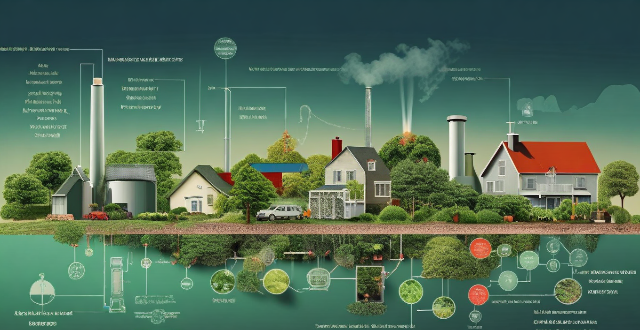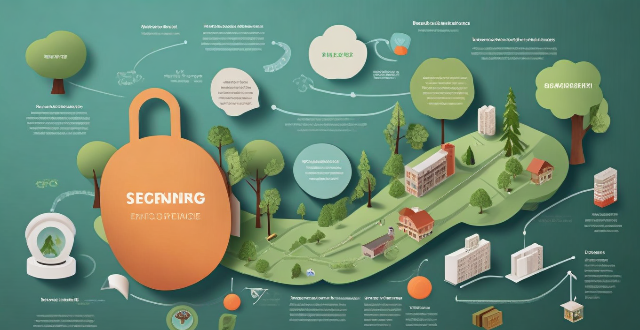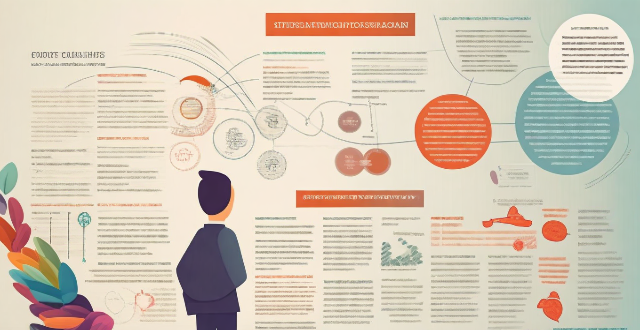Effectively Emission

Can carbon credit systems effectively combat climate change ?
Carbon credit systems are a market-based approach to reducing greenhouse gas emissions by creating financial incentives for companies and individuals to reduce their carbon footprint. While these systems can effectively incentivize reduction of emissions, promote innovation, and support sustainable development, they also face challenges such as lack of regulation and standardization, inequality and access issues, and limited scope of impact. Carbon credit systems should be part of a broader strategy that includes government regulations, public education, and international cooperation to effectively combat climate change.

What role do governments play in achieving global emission reduction targets ?
Governments play a crucial role in achieving global emission reduction targets by setting and enforcing environmental standards, investing in clean energy infrastructure, promoting energy efficiency, supporting research and development, and collaborating internationally. These actions help reduce greenhouse gas emissions and promote a healthier environment.

How do emission trading schemes work and are they effective ?
Emission trading schemes are market-based mechanisms designed to regulate the release of pollutants, especially greenhouse gases like CO2. These schemes operate on a "cap and trade" principle, whereby a regulatory body sets a limit on emissions, allocates emission allowances, and allows businesses to buy and sell these allowances in a marketplace. Companies must monitor and report their emissions, facing penalties for non-compliance. The effectiveness of such schemes varies but offers advantages like cost-efficiency, flexibility, and innovation incentives. However, challenges include complexity, political will, leakage, and equity concerns. Case studies like the EU ETS and California's Cap-and-Trade Program show mixed results, indicating that while emission trading schemes can be effective, their success depends on careful planning, robust implementation, and continuous evaluation.

What are the challenges faced by developing countries in emission reduction ?
Developing countries face numerous challenges in reducing their greenhouse gas emissions, including lack of financial resources, technological constraints, socio-economic factors, policy and regulatory challenges, cultural and educational barriers, and natural resource availability. These challenges highlight the complex nature of emission reduction efforts in developing countries and underscore the need for international cooperation, financial assistance, and technology transfer to support their transition to a low-carbon future.

Are current emission reduction efforts enough to combat climate change ?
The article discusses whether current efforts to reduce emissions are sufficient to combat climate change. It outlines various initiatives, including national pledges, renewable energy expansion, energy efficiency measures, carbon pricing mechanisms, and forest conservation. However, it argues that these efforts fall short of the required targets, pointing out gaps between commitments and reality, insufficient policy support, and challenges in changing behaviors and cultural norms. The article suggests increasing the ambition of national commitments, enhancing energy transition policies, investing in innovation and research, promoting international cooperation, and encouraging sustainable lifestyles as ways to improve emission reduction efforts.

What are some effective strategies for promoting energy conservation and emission reduction ?
Energy conservation and emission reduction are crucial for sustainable development and addressing climate change. Effective strategies include education and awareness, government policies and regulations, financial incentives and subsidies, technological innovation, infrastructure and urban planning, and individual actions. By implementing these strategies, we can work towards a future where energy is used efficiently, emissions are reduced, and our planet is protected for generations to come.

What is the impact of renewable energy on emission reduction goals ?
The shift to renewable energy sources such as solar, wind, hydro, and geothermal power is vital for reducing greenhouse gas emissions and achieving global emission reduction goals. This transition brings multiple benefits including decreased reliance on fossil fuels, improved air quality, enhanced energy security, economic stimulation through job creation and long-term cost savings, technological innovation leading to reduced costs, and significant contributions to mitigating climate change. As technology advances and economies of scale are achieved, renewable energy's role in facilitating further progress toward emission reduction objectives will become increasingly important.

What are the main objectives of energy conservation and emission reduction policies ?
Energy conservation and emission reduction policies aim to achieve several key objectives that are crucial for the sustainable development of our planet. These objectives can be broadly categorized into environmental, economic, and social dimensions. The main goals include reducing greenhouse gas emissions, protecting ecosystems and biodiversity, improving air quality, enhancing energy efficiency, stimulating innovation and job creation, reducing dependence on fossil fuels, promoting equitable access to energy, and raising awareness and education. By addressing these objectives, these policies play a crucial role in steering our societies towards a more sustainable future.

Can energy conservation and emission reduction policies help combat climate change ?
Energy conservation and emission reduction policies are essential for combating climate change. These policies aim to reduce energy consumption, promote renewable energy sources, and decrease greenhouse gas emissions. Improving energy efficiency and encouraging energy conservation can significantly reduce energy consumption. Increasing investment in renewable energy technologies and supporting research and development of clean energy technologies can help reduce reliance on fossil fuels and decrease greenhouse gas emissions. Implementing carbon pricing mechanisms and regulating industrial emissions are also important strategies for reducing greenhouse gas emissions. Overall, these policies play a vital role in mitigating the effects of climate change and working towards a more sustainable future.

How does deforestation affect global emission levels and what can be done about it ?
Deforestation significantly contributes to global emission levels, primarily through the release of carbon dioxide (CO2) and other greenhouse gases. When trees are cut down or burned, the carbon they have absorbed from the atmosphere during their lifetime is released back into the air. This process exacerbates climate change by increasing the concentration of atmospheric CO2 and other greenhouse gases, which trap heat in the Earth's atmosphere. To mitigate the effects of deforestation on global emissions, various strategies can be implemented, including reforestation, sustainable forest management, reducing demand for forest products, promoting eco-friendly alternatives, strengthening laws and policies, and raising public awareness about the importance of forests in mitigating climate change. By taking these steps, it is possible to reduce the contribution of deforestation to global emissions and work towards a healthier planet.

How do I manage my sports career effectively ?
Managing a sports career effectively involves physical training, mental preparation, strategic planning, lifestyle balance, health and wellness, networking and media relations, financial management, and continuous learning and self-improvement. Key elements include regular workouts, rest and recovery, nutrition, cross-training, visualization techniques, stress management, goal setting, mindfulness practices, long-term and short-term objectives, competition scheduling, sponsorship and partnerships, education and personal development, social life, hobbies and interests, regular check-ups, injury prevention, mental health support, building connections, media training, social media presence, budgeting, investments, tax planning, feedback, educational resources, and adaptability. By focusing on these areas, athletes can develop a comprehensive plan to manage their sports career effectively while maintaining a healthy and balanced lifestyle.

Can green bonds help fight climate change effectively ?
Green bonds, a type of fixed-income instrument, are issued to fund environmentally friendly projects that aim to reduce greenhouse gas emissions and promote sustainable development. They can effectively contribute to the fight against climate change by incentivizing renewable energy projects, supporting energy efficiency and conservation, investing in low-carbon infrastructure, promoting sustainable agriculture and forestry, and advancing research and development. However, challenges such as ensuring transparency and accountability, achieving scale and impact, integrating with broader climate strategies, and engaging diverse investors must be addressed to fully realize their potential. As the market for green bonds grows, they remain an important tool in combating climate change effectively.

How can individuals contribute to emission reduction efforts ?
Climate change is a pressing global issue that requires collective action. Individuals can contribute to emission reduction efforts by reducing energy consumption, switching to renewable energy sources, reducing waste, planting trees, and advocating for change. By adopting eco-friendly habits and supporting systemic change, we can all help mitigate the effects of climate change and create a healthier planet for future generations.

How do I use Siri effectively to get things done on my iPhone ?
The article provides a comprehensive guide on how to use Siri effectively on iPhone. It outlines the steps to set up and enable Siri, lists common commands for performing tasks such as making phone calls, sending text messages, setting reminders, creating events, playing music, getting directions, checking the weather, searching the web, and opening apps. Additionally, it explains how to customize Siri by creating custom phrases for specific tasks and offers tips for using Siri more effectively, including speaking clearly and concisely, using natural language, taking advantage of Siri's learning capabilities, and integrating Siri with other apps and services.

How can educational games be designed to effectively enhance learning ?
Designing educational games that effectively enhance learning involves a combination of educational theory, game design principles, and an understanding of the target audience. To create engaging and effective educational games, it is crucial to identify learning objectives, understand the target audience, incorporate educational theory, use engaging game mechanics, incorporate multimedia elements, provide opportunities for practice and repetition, include assessment and feedback mechanisms, foster collaboration and social interaction, and iterate and refine the game. By following these guidelines, you can design educational games that effectively enhance learning by engaging players, providing meaningful experiences, and fostering long-term retention of knowledge and skills.

How can physical education be integrated into the school curriculum effectively ?
Integrating physical education into the school curriculum effectively involves establishing clear objectives, incorporating PE into the daily schedule, offering a variety of activities, collaborating with other subject areas, encouraging student participation and choice, assessing progress, providing professional development opportunities, and creating a supportive environment. These strategies aim to promote student health, well-being, and academic performance by fostering physical fitness, motor skills, sportsmanship, and teamwork.

Can we achieve a zero-emission economy by 2050 ?
The question of whether we can achieve a zero-emission economy by 2050 is a complex one that involves multiple factors. Key points to consider include the current state of emissions, challenges to achieving zero emissions, and potential pathways to achieving this goal. Currently, global emissions are still rising, with the transportation sector being a major contributor. While there have been significant advancements in renewable energy technologies, their adoption rates vary widely across different regions. Challenges to achieving zero emissions include building the necessary infrastructure for a zero-emission economy, political will, and public acceptance. Governments must be willing to implement policies that support the transition to a zero-emission economy, and the public must be willing to adopt new technologies and change their behavior to reduce emissions. Potential pathways to achieving zero emissions include increased investment in renewable energy, electrification of transportation, carbon capture and storage (CCS) technology, changes in consumer behavior, and international cooperation. Achieving a zero-emission economy by 2050 is an ambitious goal, but it is not impossible. It requires concerted efforts from governments, businesses, and individuals worldwide. By investing in renewable energy, electrifying transportation, implementing CCS technology, changing consumer behavior, and cooperating internationally, we can make significant progress toward this goal. However, it is essential to recognize that achieving a zero-emission economy is not just about technology; it also requires political will and public acceptance.

How do energy conservation and emission reduction policies impact the economy ?
Energy conservation and emission reduction policies have both positive and negative impacts on the economy. Positively, they create new jobs, promote innovation, improve public health, and enhance energy security. Negatively, they can increase operating costs for businesses, lead to job losses, slow down economic growth, and entail significant adjustment costs. It is crucial for policymakers to carefully consider these factors when designing and implementing sustainability initiatives.

How does a carbon credit system work ?
A carbon credit system is a market-based approach that incentivizes companies, organizations, and individuals to reduce their greenhouse gas emissions. It works by setting emission reduction targets, generating carbon credits for verified emission reductions, allowing the trading of these credits, and using them for regulatory compliance or offsetting emissions. This system fosters economic efficiency, flexibility, and innovation while encouraging global cooperation on climate action. However, challenges such as ensuring permanence of reductions and maintaining system integrity must be addressed to ensure its effectiveness.

In what ways can developing countries participate effectively in global climate governance ?
**How Developing Countries Can Effectively Participate in Global Climate Governance** Developing countries are pivotal in global climate governance due to their disproportionate impact from climate change. Their effective participation can be achieved through several strategies: 1. **Capacity Building**: This involves enhancing educational programs to raise climate awareness and training local experts. It also includes investing in sustainable infrastructure and establishing research institutions. 2. **Policy Integration**: Countries should enact climate-related legislation, set emission reduction targets, and ensure policy alignment across different sectors while engaging stakeholders. 3. **Finance and Investment**: Access international and domestic funds for climate action, and make smart investments in renewable energy and sustainable agriculture. 4. **Technology Transfer and Innovation**: Developing countries should form technology partnerships, create exchange platforms, and encourage local innovation through R&D and incentives. 5. **Participation in International Negotiations**: They should prepare well for negotiations, build coalitions, advocate for their interests, and use forums for dialogue at international conferences. Through these strategies, developing countries can not only protect themselves but also significantly contribute to the global fight against climate change.

How can governments encourage companies to adopt energy conservation and emission reduction measures ?
Governments can encourage companies to adopt energy conservation and emission reduction measures by implementing a combination of strategies including financial incentives, regulatory measures, information and education campaigns, research and development support, public procurement policies, and partnerships and collaborations. These efforts not only contribute to environmental sustainability but also foster innovation and economic growth in green industries.

What are the benefits of implementing energy conservation and emission reduction policies in businesses ?
Implementing energy conservation and emission reduction policies in businesses can bring numerous benefits. These benefits include environmental protection, cost savings, increased efficiency, competitive advantage, government incentives, investor appeal, improved public image, job creation, and positive community impact. By adopting these policies, businesses can contribute to a more sustainable future while also enhancing their own success and growth potential.

How effective has the Paris Climate Agreement been in reducing carbon emissions ?
The Paris Climate Agreement, adopted in 2015, aims to limit global warming. It has seen near-universal participation and relies on voluntary emission reduction pledges by countries. However, challenges include a lack of enforcement, insufficient ambition in targets, and uneven progress. Global emissions continue to rise, and greenhouse gas concentrations are reaching new highs. The agreement's effectiveness is limited, requiring stronger commitments for significant and lasting emission reductions.

Can carbon capture help us achieve our climate goals ?
Carbon capture and storage (CCS) has the potential to mitigate climate change by capturing CO2 emissions from power plants and industrial processes, preventing them from entering the atmosphere. The captured CO2 can be transported to a suitable location for long-term storage or used for enhanced oil recovery. However, CCS technology faces challenges such as high costs, energy losses, and public acceptance issues. While it is not a silver bullet, CCS could play a valuable role in reducing greenhouse gas emissions when integrated with renewable energy strategies and energy efficiency measures.

What is a carbon credit system ?
Carbon Credit System: A market-based approach that incentivizes the reduction of greenhouse gas emissions by allowing trades of emission allowances and investments in emission-reducing projects. It operates on principles like emissions trading, offsetting, and regulation to drive environmental benefits and innovation. However, challenges such as quality assurance, persistence in reducing actual emissions, and equity concerns need to be addressed for its effective implementation.

What are the benefits of implementing a carbon credit system ?
The carbon credit system is a market-based approach to reducing greenhouse gas emissions. It provides economic incentives for emission reduction, promotes innovation and technology adoption, enhances environmental stewardship, and serves as a regulatory and policy tool. By creating a market value for emission reduction, the system encourages businesses to reduce their carbon footprint and fosters global cooperation towards sustainability goals.

What role do individuals play in achieving the goals of energy conservation and emission reduction policies ?
The article discusses the critical role of individuals in achieving energy conservation and emission reduction policies. It emphasizes the importance of individual action, highlighting the collective impact of small changes and the potential for behavioral change. The article provides various ways individuals can contribute, such as reducing energy consumption, reducing waste, supporting renewable energy, and advocating for change. It concludes by emphasizing the power of individuals to bring about change and safeguard the planet for future generations.

How do carbon credits contribute to reducing greenhouse gas emissions ?
Carbon credits are a key tool in the fight against climate change, as they incentivize emission reductions, facilitate international cooperation, support sustainable projects, enhance transparency and accountability, and promote market efficiency. By creating economic value for carbon reduction efforts, stimulating innovation, meeting global targets, sharing mitigation burdens, financing renewable energy and forest conservation projects, ensuring rigorous monitoring and verification, promoting cost-effective abatement, and providing clear price signals, carbon credits play a crucial role in reducing greenhouse gas emissions.

Are there any international agreements or initiatives related to energy conservation and emission reduction ?
The article provides an overview of several international agreements and initiatives related to energy conservation and emission reduction. These include the United Nations Framework Convention on Climate Change (UNFCCC), the International Energy Agency (IEA), the Clean Energy Ministerial (CEM), the Global Green Growth Institute (GGGI), and the Renewable Energy Policy Network for the 21st Century (REN21). The objectives, key elements, and achievements of each are discussed in detail. The article concludes by emphasizing the importance of these collaborative efforts in addressing climate change and ensuring sustainable development.

Can you explain the Kyoto Protocol and its impact on international climate policy ?
The Kyoto Protocol, an international environmental treaty adopted in 1997 and effective from 2005, is a legally binding agreement aimed at reducing greenhouse gas emissions to combat climate change. Named after Kyoto, Japan, where it was signed, the protocol has significantly influenced international climate policy by establishing specific emission reduction targets for developed countries, introducing market-based mechanisms like Joint Implementation and Emissions Trading, promoting the Clean Development Mechanism, enhancing international cooperation, sparking debates on global versus national responsibility, and influencing subsequent climate agreements like the Paris Agreement.